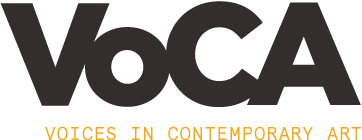Editor’s Note
Welcome to the Spring 2016 edition of VoCA Journal. In this issue, our contributors explore the importance of specific times and places in the development of their work, and confess to the sensory lures of materials.
Chris Kallmyer and Jonathan Allen discuss the relative merits of artist residency programs that offer solitude versus others that focus on social participation. Opportunities to engage with particular communities and locations are key for Kallmyer, who gives as an example Commonfield Clay, a project he produced during a residency at Pulitzer Arts Foundation in St. Louis. The work, for which Kallmyer created earthenware chimes from local clay and then played them with local artists in a public concert, was “hyper-regional and a true amalgam of the place.”
Ariel Plotek (Associate Curator of Modern Art at the San Diego Museum Art) delights in the “tension between arid fields of pigment and sumptuous cascades of gold, silver, and platinum” he discovered in Nancy Lorenz’s paintings. In their interview, Lorenz recalls drawing inspiration from the periodic table of elements, “the perfect metaphor to allow me to organize my interest in materials,” and explains how the experience of growing up in a Tokyo hotel helped shaped her aesthetic.
Lucy Bradnock (Assistant Professor, History of Art at the University of Nottingham) speaks with Rachel Rivenc (Associate Scientist with the Modern and Contemporary Art Research Initiative at the Getty Conservation Institute) about the blending of social history, art history and material studies in Rivenc’s new book, Made in Los Angeles: Materials, Processes, and the Birth of West Coast Minimalism. Considering the art of that period, Bradnock and Rivenc reflect on the paradox between cool, non-expressive surfaces that appear as though they were industrially produced, and the intensive labor and high level of skills necessary to achieve those surfaces.
It was a pleasure to interview independent art historian Marina Pugliese about the collaborative research model she is using to produce a major exhibition of Lucio Fontana’s light environments. When asked what makes Fontana’s little-known environmental works so compelling, Pugliese explains that Fontana spent his life exploring the threshold between materiality – for instance, the use of fluorescent colors on papier-mâché – and immateriality, such as the effect of black light in a dark gallery. Reconstructing Fontana’s environments from the 1950s and 1960s will give new generations a chance to understand the artist’s groundbreaking approach to constructing space.
Robin Clark


